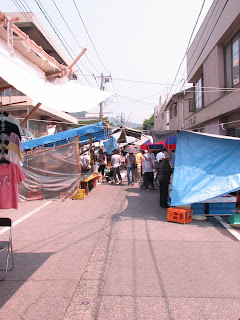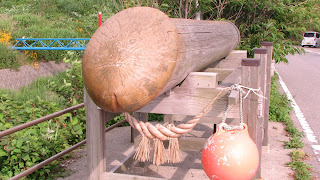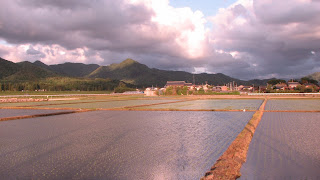This post is being written on a stomach full of
ika (squid) from today's school lunch. They pound the surface into a texture resembling that on a meat-tenderizing hammer, and then cook it for a good long time (presumably to aid with polymerization or something). Just an anecdote, but some days are better than others, with regard to school lunches.
~
I'm starting to feel the pressures of leaving, and wavering between excitement, uncertainty, and regret (all the usual emotions for any transition, in other words). I also stumbled upon a
blog entry by a friend whom I'm guessing some of you may know, which deals with all the same emotions, except coming from someone who's been in Germany for about a year. I'd also recommend the rest of her blog, if you have some time to burn- she's a good writer and has had some interesting experiences.
Anyways;
The specter of my departure is looming large, and I'm starting to take mental stock of what this past year has meant for me in general, where I succeeded, where I failed, and how I feel about moving on.
One thing that will ease my departure is something I've noticed more and more since coming here. Hillary Clinton spoke of a "glass ceiling" during her presidential bid, metaphorically blocking women from achieving positions of prominence and power equal to those of men. In Japan, there is a glass ceiling for foreigners, which prevents them from ever reaching positions on par with those of the Japanese with whom they work. Unlike with Hillary, however, there's also what I can only describe as a
glass wall; a frigid gap between a foreigner and native Japanese that is very difficult to bridge- I'm honestly not sure whether I have or not, although I think I may getting there with some of my younger elementary school teachers. It is an unfortunate reality, however, that the majority of ALTs I know do not spend much, if any, time with close Japanese friends. The Japanese network of relationships runs lambent over every surface around me, but I can never actually seem to grasp it.
The official JET materials forecast this kind of Mime's-box difficulty, and have a number of recommendations for what one can do to improve one's situation. However, it seems to me like the implicit assumption in those materials is that if you aren't getting along with people, you've screwed up somehow. While it's true that making a concerted effort can
massively improve one's social experience here, I don't feel like individual initiative is the whole story here: Japanese culture, as fascinating and beautiful as it is, has a long-running xenophobic streak. When I started working on this post, I thought I would put down some of the history to back up this statement in this post, but then realized that it would make for a rather ponderous read (more so than it is already becoming). Rather- here are some links to pertinent articles:
SakokuKanagawa TreatyRacial Issues in JapanKoreans in JapanAinu HistoryBurakuminLittle Black SamboGaijinReading things like this, as well as my a couple of my own experiences:
Being excoriated by a racist man for the better part of 30 minutes during the
matsuri in
Iwafune,
and
Having a 5th grader point at the picture I'd put up of a Papua New Guinean child on the slide projector and say "monkey," while the teacher did nothing about it (I didn't quite catch his face, or else I would have disciplined him pretty harshly).
Finally, being stared at all the time, and always treated either as a special novelty, or a special problem, but never a normal manifestation of either, becomes more burdensome with the passage of time. Not less. This kind of ethnic "specialness" has gotten exhausting enough that I'm ready to escape into the dark, comforting arms of anonymity back in America, where I don't stick out like a Giraffe in a rabbit warren.
That's the bad part.
________________________
I'm also very sad to leave, however, particularly my elementary schools. These schools that I so dreaded upon my arrival have proved to be the sites of some of the most fun and rewarding work I've ever done. Contrary to the dreary picture I just painted above, the staff are almost entirely wonderful people. Among the teachers at my
shogakko, I now feel very comfortable and at-home, chatting about a number of things in between and after classes, and pulling them into the English lessons with their students.
It's the students, however, that I'll be more sad to leave than anything. Nothing I've seen here, however ancient or exotic, can compare to how rewarding it has been to get to know the kids that I work with, and to establish actual relationships of trust and love such as one only can with young children. It's difficult to put into words, in any meaningful way, the difference that these relationships have made for me (and I hope for the children, too). English doesn't want for negative descriptors, but trying to describe the positive gravitas that a good relationship with a child (or many children) can exert on oneself would require either great poetry or great narrative, neither of which I am capable of conjuring in the middle of this post. Suffice to say- the effects of getting to know the children with whom I work have been only as overwhelming as they have been positive.
Prior to coming here, I never quite understood people that "love children." My understanding now is that you don't really
love children- children just love
you with such ebullient energy that it is impossible not to reciprocate.
________________________
And so, once all the dross has run off, what remains is relationships. Some of my most stressful times in Japan, and most rewarding, have been the result of how I've interacted (or not interacted) with people here. I think that severing the old set, and moving back to a combination of an older set and a new set, is what is generating the most distress for me right now. I'll be very pleased if I managed to navigate the transition with something resembling grace. Finding a job other than something like poop shoveler or rock scrubber also wouldn't hurt.
So endeth my June 1st introspective post. Thanks for indulging me a little bit in a break from the regular program of photos and information about Japan. Such as I have the time, I will be posting some general photos of Niigata in Spring that defy event-specific categorization. I'm also doing some research for a post about Buddhism in Japan, such as I've encountered it, and hopefully that too will ripen enough to be put on the vine for you all (sometimes you have to yank a metaphor inside out to fit it onto the internet).
Thanks for reading!
otsukarasamadeshita.



























